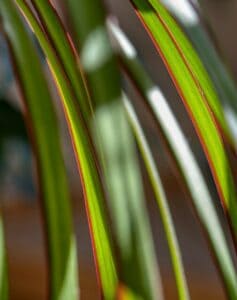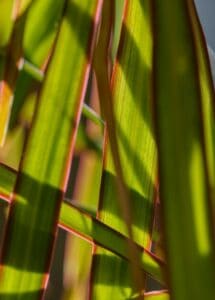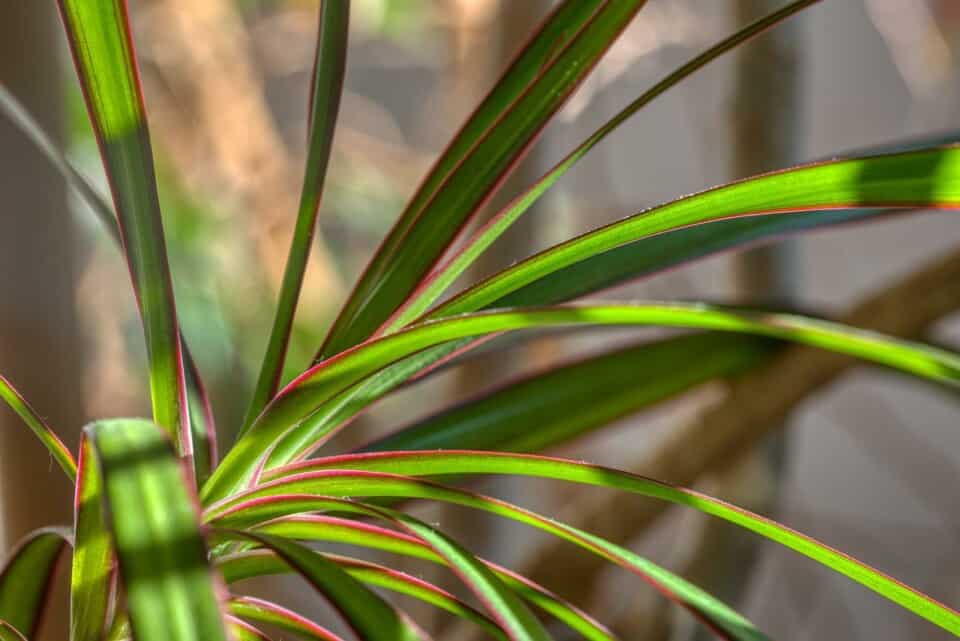Some links in the post are affiliate links and I get a commission from purchases made through some links found in the post.
Dracaena plants are frequently used as pieces of decor because a healthy dracaena is indeed beautiful and will grace any home or office.
Not only are they beautiful, but they also help to keep the air pure and clean. Drought resistant and hardy, they are easy to maintain.
One of the biggest challenges you may face with the Dracaena is that the leaves start to droop. Drooping leaves give the plant an unhealthy appearance and take away the beauty of the plant.
There are several reasons why your Dracaena may start to droop. In fact, some drooping of the leaves is normal for many plants and the Dracaena is no different here.
However, when the top leaves start to droop it can and should be a cause for concern.
The main reason your dracaena is drooping is due to watering problems (overwatering, underwatering the water quality).
Other reasons your dracaena may be drooping could be due to fungus issues, light and temperature problems, root problems, bug infestations, overgrown stems and light issues.
The good news is that drooping leaves can be restored, and with a little bit of attention your Dracaena will soon be beautiful again.
A Little About the Dracaena Plant
 Dracaena plants will grow in an upright form and can reach anywhere between 2-3 metres in height. The stems are called canes and can be pruned to keep the growth under control.
Dracaena plants will grow in an upright form and can reach anywhere between 2-3 metres in height. The stems are called canes and can be pruned to keep the growth under control.
The origins of the Dracaena plant are in the Indian Ocean and Madagascar. The name comes from the ancient Greek word ‘drakaina.’ In English this means female dragon and it is so called because of the red gum resin.
Long ago the resin was used for dyes, toothpaste and even medicine. Even these days it is still used in products like varnish.
Dracaena plants are very popular as houseplants, as well as garden plants. In subtropical climates they can be easily grown outdoors.
Why is my Dracaena Drooping?
It can be very disconcerting to see a Dracaena plant with drooping leaves, but fortunately this can be rectified.
As with most plants, either inside or outdoor plants, when their living conditions are not as they desire, they will manifest in different ways.
The Dracaena is no different in this and drooping is one of the fastest ways to tell that your plant is not as happy as it would wish..
Let’s look at some of the most common reasons for a Dracaena to droop.
1) Check the Water Schedule
This is normally the first reason for your Dracaena to start to droop and it is one of the easiest issues to fix.
Because the Dracaena falls into the category of drought-resistant, it has different watering needs to most other household plants.
Dracaena’s do not need to be watered more than once a week. They have no problems if you only water them every ten days. This depends on the amount of humidity in your home.
Like many household plants, Dracaena’s do not like their roots to be too wet as this will cause them to rot. Your plant will start to droop and eventually the leaves will fall off.
How to Fix a Watering Schedule
The first thing to do is to stop watering your Dracaena and let the soil dry out. Now look at the soil and make sure that it is well draining and that there are holes in the base of the pot. If there are no holes then you should change the pot.
If your plant is on the same watering system as other plants then you should change it right away. Dracaena do not need as much as other indoor plants, and they will let you know by drooping.
You can also change the potting mix for your Dracaena to a 1:1:1 mixture. This means it is one part perlite, one part soil and one part peat moss. This mixture will provide good drainage for your plant.
You may want to check the holes at the base of your pot and make a few more as many pots do not have more than one or two holes, which is not enough for the Dracaena.
Once you have sorted out the water/drainage issues you should let your plant dry out completely before watering it again.
It is good to remember that although your plant has dried out, you should not leave it this way for too long as drooping can occur from underwatering as well as from overwatering.
You may also like: How to save a dying dracaena marginata plant
2) Water Quality
Water differs from region to region and some water is not suitable for Dracaena plants. Many homes have water which comes from municipal water treatment plants, and this will normally contain chlorine.
Dracaena plants do not do well with highly chlorinated water and neither do they happily tolerate salt water.
How to Fix the Water Quality
You will be able to remove chlorine by using a filter or by boiling the water and letting it cool down. A filter will remove impurities in the water and make it more acceptable for your Dracaena.
You can also let your tap water stand for 48 hours or longer before using it on the plants. This will give the chlorine time to evaporate.
Not everyone has access all the time to bottled water for their Dracaena so simply standing the tap water is a cheap and easy alternative.
3) Fungus
Drooping leaves may be a sign that your dracaena has a fungus which may work upwards from the roots to the stems.
You will know that the plant has a fungal attack by gently squeezing the stem as close to the soil as possible. If it feels soft and mushy, or slimy, then it is likely that the fungus has affected the root system.
How to Fix Fungus Problems
This is one issue which may mean that you lose your plant although it is always worth repotting the plant.
You should flush the soil thoroughly and then sprinkle with cinnamon before repotting in fresh soil. This may or may not work, but it is always worth trying on a plant. There is nothing to lose and you may save your Dracaena.
If you’re enjoying this article, check out our article on what is the best soil for a dracaena marginata.
4) Light and Temperature Problems
 Your Dracaena needs indirect bright light to grow. It will not tolerate direct sunlight because the sun will burn the foliage and cause it to start drooping.
Your Dracaena needs indirect bright light to grow. It will not tolerate direct sunlight because the sun will burn the foliage and cause it to start drooping.
Neither do Dracaena’s like fluctuations in temperatures. They are happiest where the air temperature is constant and do best in the range of between 60 degrees F and 70 degrees F. Too high temperatures will cause the leaves to droop.
If your plant is constantly exposed to high temperatures you will find that it is drooping due to dehydration. You should remove it from the hot area and water it. Watch to ensure that it recovers – this will be visible within a few hours.
How to Fix Light and Temperature Problems
Make sure that you are not placing your Dracaena near any air conditioning vents and that it is not in a draught. Both excessive heat and cold are not good for these plants.
Stay away from bright sunny spots and opt for a place where there is plenty of light but indirect, rather than direct.
5) Watch the Roots
Dracaena do not like their roots to be cramped and if they are, you will see drooping leaves.
It is always a good idea to check the conditions of the pot as soon as you bring your plant home from the garden centre. It may have been left in the same pot for too long and the roots become cramped.
How to fix the Roots
Lift the pot up and check the drainage holes on the bottom. If you can see the roots, then it is time to repot your plant. Certainly, if the roots are starting to grow through the holes then you should repot as soon as possible.
Move your Dracaena into a pot which is about 2 inches larger than the root ball. This will give your plant enough space to spread out its roots.
Too large an increase in the new pot size is detrimental as it can result in too much water remaining in the soil and causing root damage. The rule of thumb is to repot into pots which are no more than 2 inches in diameter larger.
You may also like: How to care for a dracaena outdoors
6) Bugs
Very occasionally your Dracaena will be affected by pests, and this may cause the leaves to droop.
Common pests are aphids and mealy bugs. These little creatures feed on the juice sucked from the plant leaves.
How to Fix Bug Problems
Opt for an insecticidal soap or Neem oil, both of which will stop the infestation. You can also use a cotton ball dipped in rubbing alcohol to wipe the leaves and rid them of pests.
7) Overgrown Stems
If your Dracaena is a mature plant and starts to droop then take a look at the amount of growth.
Left unpruned the Dracaena will end up with more than one stem and plenty of growth which can get heavy if unchecked.
You will notice that most Dracaena do not have very thick stems so having a heavy number of leaves can become difficult to support.
How to Fix Overgrown Stems
Dracaenas are slow growers so you may be put off by the idea of heavy pruning but rest assured that it will be worth it in the long run. Your plant will be happier, and the leaves will stop drooping.
Another alternative to this, if you prefer not to heavily prune your plant, is to place a stake against the stem and secure it so the plant stays upright, although the leaves may still droop as they make the plant top heavy.
You may also like: 5 great benefits of a dracaena for your home
Let’s Look at one Other Issue your Dracaena may Have
Low Light Issues
If the entire plant seems to be listing over to one side there may be an issue with lighting.
Plants always grow towards light and if your plant is in a spot where there in not enough light ie, low light conditions, you may see that the whole plant seems to be bending over.
Not only will your Dracaena become weak, but it will also get ‘leggy’ in an attempt to reach more sunlight. It may even snap if it bends too far in an effort to reach light.
How to fix Low Light Issues
You should move your plant as soon as possible. Choose a place where there is indirect, bright light. A good place is in a south or east facing window area. Make sure that it is not in direct sunlight as this can burn the leaves.
Moving the plant to another spot will make it less likely to lean over to one side. You can also rotate the pot every week by a quarter turn to ensure that the plant never grows towards extra light.
For more on how to fix the light issues, check out our article on the dracaena marginata light requirements.
What Does a Healthy Dracaena Look Like?
 While each variety of the species looks different, a healthy Dracaena will have a rigid stem that stands upright in the pot. The foliage should point outwards and upwards and may gently curve down at the tips.
While each variety of the species looks different, a healthy Dracaena will have a rigid stem that stands upright in the pot. The foliage should point outwards and upwards and may gently curve down at the tips.
If your Dracaena is mature then you may see the tips of the older leaves turning a little brown, this is due to the age of the plant.
The Dracaena is a slow growing plant and can take many years to reach full height which can be about 6 feet tall in the right conditions.
Leaves which start to droop and stems which start to bend are a clear indication that your Dracaena has a problem, and you should check it out before it gets worse.
Final Thoughts
A healthy Dracaena plant will enhance any home or office. They are easy to maintain and although they need a different watering routine than many other household plants, it is easy to change to suit their needs.
When your Dracaena is placed in a good spot, free from draughts and temperature fluctuations and in a correctly sized pot, you can expect many years of growth.
It is also good to know that the full size of the Dracaena plant is not more than 6 feet so you can be assured that in the future you will not have a monster plant taking over your office or living room.
Before you go, here are some more related articles I encourage you to read below to help solve more of your gardening issues:


